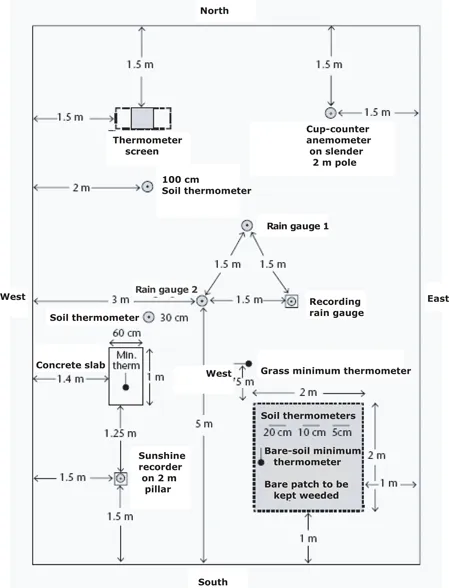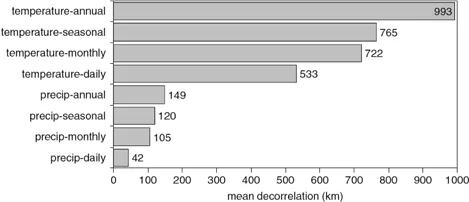
eBook - ePub
Geographical Information and Climatology
Pierre Carrega, Pierre Carrega
This is a test
Compartir libro
- English
- ePUB (apto para móviles)
- Disponible en iOS y Android
eBook - ePub
Geographical Information and Climatology
Pierre Carrega, Pierre Carrega
Detalles del libro
Vista previa del libro
Índice
Citas
Información del libro
This book includes two parts. The first part is more theoretical and general, and it covers fundamental principles: geospatial climate data measurement; spatial analysis, mapping and climate; geographical information, remote sensing and climatology; and geographical information for initialisation of forecasting and climate models.
The second part describes geographical information used in various climate applications of importance today, related to risk: urban climate; air pollution; hydrological problems linked to climatology; forest fires.
Preguntas frecuentes
¿Cómo cancelo mi suscripción?
¿Cómo descargo los libros?
Por el momento, todos nuestros libros ePub adaptables a dispositivos móviles se pueden descargar a través de la aplicación. La mayor parte de nuestros PDF también se puede descargar y ya estamos trabajando para que el resto también sea descargable. Obtén más información aquí.
¿En qué se diferencian los planes de precios?
Ambos planes te permiten acceder por completo a la biblioteca y a todas las funciones de Perlego. Las únicas diferencias son el precio y el período de suscripción: con el plan anual ahorrarás en torno a un 30 % en comparación con 12 meses de un plan mensual.
¿Qué es Perlego?
Somos un servicio de suscripción de libros de texto en línea que te permite acceder a toda una biblioteca en línea por menos de lo que cuesta un libro al mes. Con más de un millón de libros sobre más de 1000 categorías, ¡tenemos todo lo que necesitas! Obtén más información aquí.
¿Perlego ofrece la función de texto a voz?
Busca el símbolo de lectura en voz alta en tu próximo libro para ver si puedes escucharlo. La herramienta de lectura en voz alta lee el texto en voz alta por ti, resaltando el texto a medida que se lee. Puedes pausarla, acelerarla y ralentizarla. Obtén más información aquí.
¿Es Geographical Information and Climatology un PDF/ePUB en línea?
Sí, puedes acceder a Geographical Information and Climatology de Pierre Carrega, Pierre Carrega en formato PDF o ePUB, así como a otros libros populares de Ciencias físicas y Meteorología y climatología. Tenemos más de un millón de libros disponibles en nuestro catálogo para que explores.
Información
Chapter 1
Basics of Climatological and Meteorological Observations for GIS Applications 1
Weather and climate data are spatially distributed. Geographical information technologies can therefore provide a useful and relevant working environment for the distribution, integration, visualization, and analysis of these data. However, compared to other scientific areas, the application of geographical information system (GIS) tools was for a long time a clumsy process within meteorology and climatology, and especially within most national meteorological services (NMS); because of the shortcomings of GIS related to the underlying data model and missing interfaces to standard meteorological tools (e.g. weather forecast model). While the GIS data models are highly static based, meteorological data models have a need for a strong dynamical component with causal dependencies in the space/time domain (see for example [CHR 02]). Nativi et al. [NAT 04] describe the differences between both underlying data models and advocate models that are supported by so-called interoperability services. In addition to these differences in the data models, there are significant differences in the spatial modeling approaches. In general, GIS environments have implemented the geo-statistical modeling tools that are based on one temporal realization only, whereas meteorological data offer the temporal sample in addition to the spatial sample, which results in different spatial modeling approaches [SZE 04]. However, within the last few years efforts for integration of meteorological data models in GI environments were quite successful, and well-established GIS web-mapping standards and spatial infrastructures have gained increasing importance in meteorology and climatology. Thus parallel efforts and development currently appear to be resolved [SHI 05].
Information to be derived from climate variability analyses is strongly dependent not only on the spatiotemporal density, but also on the quality of the available data. Today it is a well-established fact in climatology that the climate signal from measurements, beside the statistical noise, is by inhomogenities. Therefore, a primary step of climate studies is to analyze the input data used with respect to quality and homogenity, which makes the results uncertain regarding input data, in addition to the uncertainty of the approach. Quantifying quality and homogenity of the data require data about the data itself (the metadata). Nowadays, metadata are highly standardized for GI data (e.g. see the Open GIS Consortium activities), but the information obtained from metadata regarding climate data is still heterogenous. However, the NMSs and the WMO (World Meteorological Organization) are aware of the importance of climate metadata, which resulted in several efforts for standardization of metadata (see e.g. [AGU 03]). To summarize these efforts, it can be stated that in climatology metadata information is related to the documentation of the “where”, “when”, and “how” of measurements, whereas metadata in GI science also add emphasis to the usability of the data.
In this chapter, basic concepts of climate networks and climate data are presented. This includes an overview of standards of climate measurements, description of climate data types, spatial reference of data, as well general comments on accessing the data. The areas of climate data quality and homogenity are reviewed in depth, covering the important aspects of metadata description. The chapter does not tackle climate model data and only introduces climate reanalysis data.
1.1. Data measurements and observations in climatology
1.1.1. Networks and concepts for meteorological/climate data
Meteorological measurements are motivated by the primary aim of predicting the Earth’s weather with the highest possible precision. This aim results in measurements covering the entire Earth (for both the land and the sea), but also encompassing the third dimension (vertical sounding of the atmosphere by radio sounds, satellite sensors, radar, etc). Beside weather forecasting, meteorological services are responsible for monitoring the state and spatiotemporal change of the climate. As these two basic aims do not coincide with respect to network performance, two different networks have been established in public weather services, the synoptic and the climate network. Whereas, the stations and instruments are identical, the networks differ in their interval, quantity, availability and time of observations. Moreover, the synoptic network is characterized by the need for a much larger spatial extent and more detailed information on past and current weather situations. In contrast, climate networks are characterized by higher demands on data quality. All national meteorological/climatological networks are coordinated on an international level by the WMO.
The need for meteorological/climatological networks is met by in situ measurements and by remote sensing techniques. Consequently, the WMO Global Observing System is composed of the surface-based subsystem and the space-based subsystem. The surface-based subsystem includes different types of station networks (e.g. surface synoptic stations, climatological stations), whereas the space-based subsystem comprises, for example, on-board sounding from spacecraft. The observational requirements of a climatological station or synoptical station are detailed in [WMO 03] and include: present weather, past weather, wind direction and speed, cloud amount, cloud type, cloud-base height, visibility, air temperature, relative humidity, air pressure, precipitation, snow cover, sunshine duration or solar radiation, soil temperature, evaporation.
Figure 1.1. Layout of an observing station in the northern hemisphere showing minimum distances between installations (from [WMO 08])

An important concept behind climate observations is representativeness, which is the degree to which the observation accurately describes the value of the variable needed for a specific purpose. Therefore, it is not a fixed quality of any observation, but results from joint appraisal of instrumentation, measurement interval and exposure against the requirements of some particular application [WMO 08]. An estimate of spatiotemporal representativeness of air temperature and precipitation is shown in Figure 1.2, with much higher spatial correlation for air temperature compared with precipitation. It can be concluded from this results that station density has to be much higher for precipitation compared with air temperature and that station density has to be increased for investigations with increasing temporal resolution.
Figure 1.2. Average decorrelation distances (r² decreasing below 0.5) for air temperature and precipitation in four time resolutions. Samples: daily values for all of Europe; monthly, seasonal and annual for the Greater Alpine Region (from [AUE 05])

Various meteorological applications have their own preferred timescale and space scale for averaging, station density, and resolution of phenomena. From there, for example, weather forecast requires more frequent observations compared to climate monitoring. The spatio-temporal dependency of meteorological phenomena results in simple scaling convention (see Table 1.1).
Table 1.1. Spatial and temporal scales of meteorological phenomena
| Type of motion | Spatial scale (m) | emporal scale |
| Eddy | 0.001 | 0.001 |
| Micro turbulence | 10 | 10 |
| Tornado | 100 | 60 |
| Cumulus convection | 1,000 | 20 min |
| Cumulunimbus | 100,000 | 1 h |
| Front | 100,000 | 3 h |
| Hurrican | 100,000 | 3 h |
| Cyclone | 1,000,000 | 1 d |
| Planetaric waves | 10,000,000 | 10 d |
The design of a meteorological station has to be according to the network requirements. In particular, the station site, instrument exposure and location of sensors has to be treated according to regulations. As an example, Figure 1.1 shows the layout for a typical synoptic/climatological station according to WMO regulations.
1.1.2. Standards for climate data measurements
The term “standard” is related to the various instruments, methods, and scales used to estimate the uncertainty of measurements. Amongst others, nomenclature for standards of measurements is given in the International Vocabulary of Basic and General Terms in Metrology issued by the International Organization for Standardization (ISO) [ISO 93]. The following standards are included: measurement standard, international standard, national standard, working standard, transfer standard, traceability, etc.
Meteorological observations and measurements are highly standardized from WMO or from NMSs. Such standardization is obvious if we takes into account the influence of station surroundings (surface properties, influences from nearby buildings, trees, etc) or of measurement observation procedures. From there meteorological (climatological) measurements are standardized especially with respect to:
– surface conditions in the nearby of the sensor;
– station surrounding;
– sensor-height above ground;
– procedure of reading;
– observation time.
However, practices are different and measurements are occasionally performed under conditions that are different from the required standard, which have to be archived in metadata information. This is especially true for the surface conditions in the areas around the sensor and the station, whereas sensor height and observation are generally in accordance with the standards. Standards are more accurately considered in climate networks of weather services compared with networks from other operators. When incorporating data from various other sources, the standardization regulations of the data providers should be carefully considered.
1.1.3. Climate data types
Classification of data types can be undertaken from different perspectives. Using classical classification schemes used in GI science the following types of data are used in meteorology and climatology.
– Spatial irregularly distributed point data: e.g. the station measurements and observations, vertical radio sounding data if some generaliza...